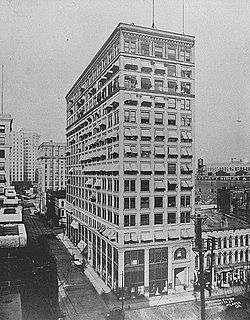| J. Mack Robinson College of Business Administration Building | |
|---|---|
 Empire Building in the early 1900s | |
Location in Downtown Atlanta | |
| Former names |
|
| General information | |
| Type | University Commercial offices |
| Location | 35 Broad Street NW corner of Marietta Street Fairlie-Poplar district Georgia State University Downtown Atlanta Georgia |
| Coordinates | 33°45′19″N84°23′24″W / 33.75523°N 84.38997°W |
| Completed | 1901 |
| Owner | Georgia State University (Georgia State Government) |
| Technical details | |
| Floor count | 14 |
| Design and construction | |
| Architect(s) | Bruce & Morgan Hentz, Reid, Adler & Shutze (remodel) |
Citizen's and Southern Bank Building | |
| Location | 35 Broad St., Atlanta, Georgia |
| Coordinates | 33°45′19″N84°23′24″W / 33.75523°N 84.38997°W |
| Area | less than one acre |
| Built | 1901 |
| Architect | Morgan & Dillon; Hentz, Adler & Shutze |
| Architectural style | Late 19th and 20th Century Revivals |
| Part of | Fairlie–Poplar Historic District (ID82002416) |
| NRHP reference No. | 77000426 [1] |
| Significant dates | |
| Added to NRHP | August 18, 1977 |
| Designated CP | September 9, 1982 |
| Designated ALB | June 4, 1992 |
| References | |
| [2] [3] [4] [5] | |
The J. Mack Robinson College of Business Administration Building is a 14-story highrise at the corner of Broad and Marietta streets in the Fairlie-Poplar district of downtown Atlanta, which houses the business school of Georgia State University. When completed in 1901 as the Empire Building, it was the first steel-frame structure and the tallest in the city, until surpassed by the Candler Building in 1906. [6] [7]
Contents
Morgan & Dillon and Hentz, Adler & Shutze were architects. In 1972, while named the Citizens & Southern National Bank Building, the structure was added to the National Register of Historic Places. [5]
The ground floor houses a full-service Bank of America branch. NationsBank purchased Citizens & Southern National Bank in 1991, and after later acquiring BankAmerica Corp., it, along with its branches, was renamed Bank of America.
The building doubled as the Illinois First Federal Savings & Loan association building in the 2016 film The Founder , a biopic of Ray Kroc starring Michael Keaton and as a bank in the opening robbery scene in the 2025 film The Naked Gun starting Liam Nelson [8]
